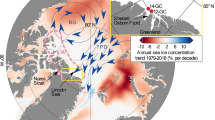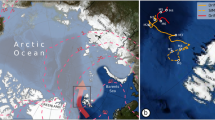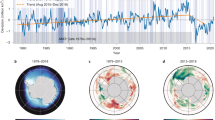Abstract
The Arctic has warmed dramatically in recent decades, with greatest temperature increases observed in the northern Barents Sea. The warming signatures are not constrained to the atmosphere, but extend throughout the water column. Here, using a compilation of hydrographic observations from 1970 to 2016, we investigate the link between changing sea-ice import and this Arctic warming hotspot. A sharp increase in ocean temperature and salinity is apparent from the mid-2000s, which we show can be linked to a recent decline in sea-ice import and a corresponding loss in freshwater, leading to weakened ocean stratification, enhanced vertical mixing and increased upward fluxes of heat and salt that prevent sea-ice formation and increase ocean heat content. Thus, the northern Barents Sea may soon complete the transition from a cold and stratified Arctic to a warm and well-mixed Atlantic-dominated climate regime. Such a shift would have unknown consequences for the Barents Sea ecosystem, including ice-associated marine mammals and commercial fish stocks.
This is a preview of subscription content, access via your institution
Access options
Access Nature and 54 other Nature Portfolio journals
Get Nature+, our best-value online-access subscription
$29.99 / 30 days
cancel any time
Subscribe to this journal
Receive 12 print issues and online access
$209.00 per year
only $17.42 per issue
Buy this article
- Purchase on Springer Link
- Instant access to full article PDF
Prices may be subject to local taxes which are calculated during checkout




Similar content being viewed by others
References
Carmack, E. et al. Toward quantifying the increasing role of oceanic heat in sea ice loss in the new Arctic. Bull. Am. Meteorol. Soc. 96, 2079–2105 (2015).
Screen, J. A. & Simmonds, I. Increasing fall-winter energy loss from the Arctic Ocean and its role in Arctic temperature amplification. Geophys. Res. Lett. 37, L16707 (2010).
Comiso, J. C. & Hall, D. K. Climate trends in the Arctic as observed from space. WIREs Clim. Change 5, 389–409 (2014).
Lind, S. & Ingvaldsen, R. B. Variability and impacts of Atlantic Water entering the Barents Sea from the north. Deep Sea Res. I 62, 70–88 (2012).
Smedsrud, L. H. et al. The role of the Barents Sea in the Arctic climate system. Rev. Geophys. 51, 415–449 (2013).
Loeng, H. Features of the physical oceanographic conditions of the Barents Sea. Polar Res. 10, 5–18 (1991).
Smedsrud, L. H., Ingvaldsen, R., Nilsen, J. E. Ø. & Skagseth, Ø. Heat in the Barents Sea: transport, storage, and surface fluxes. Ocean Sci. 6, 219–234 (2010).
Årthun, M., Eldevik, T., Smedsrud, L. H., Skagseth, Ø. & Ingvaldsen, R. B. Quantifying the influence of Atlantic heat on Barents Sea ice variability and retreat. J. Clim. 25, 4736–4743 (2012).
Lind, S., Ingvaldsen, R. B. & Furevik, T. Arctic layer salinity controls heat loss from deep Atlantic layer in seasonally ice-covered areas of the Barents Sea. Geophys. Res. Lett. 43, 5233–5242 (2016).
Fossheim, M. et al. Recent warming leads to a rapid borealization of fish communities in the Arctic. Nat. Clim. Change 5, 673–677 (2015).
Dalpadado, P. et al. Productivity in the Barents Sea—response to recent climate variability. PLoS One 9, e95273 (2014).
Bogstad, B., Gjøsæter, H., Haug, T. & Lindstrøm, U. A review of the battle for food in the Barents Sea: cod vs. marine mammals. Front. Ecol. Evol. 3, 1–17 (2015).
Eriksen, E., Skjoldal, H. R., Gjøsæter, H. & Primicerio, R. Spatial and temporal changes in the Barents Sea pelagic compartment during the recent warming. Prog. Oceanogr. 151, 206–226 (2017).
Haug, T. et al. Future harvest of living resources in the Arctic Ocean north of the Nordic and Barents seas: a review of possibilities and constraints. Fish. Res. 188, 38–57 (2017).
Rudels, B., Jones, E. P., Schauer, U. & Eriksson, P. Atlantic sources of the Arctic Ocean surface and halocline waters. Polar Res. 23, 181–208 (2004).
Gargett, A. E. & Holloway, G. Dissipation and diffusion by internal wave breaking. J. Mar. Res. 42, 15–27 (1984).
Linders, J. & Björk, G. The melt-freeze cycle of the Arctic Ocean ice cover and its dependence on ocean stratification. J. Geophys. Res. 118, 5963–5976 (2013).
Kwok, R., Maslowski, W. & Laxon, S. W. On large outflow of Arctic sea ice into the Barents Sea. Geophys. Res. Lett. 32, L22503 (2005).
Onarheim, I. H., Eldevik, T., Årthun, M., Ingvaldsen, R. B. & Smedsrud, L. H. Skillful prediction of Barents Sea ice cover. Geophys. Res. Lett. 42, 5364–5371 (2015).
Årthun, M. et al. Skillful prediction of northern climate provided by the ocean. Nat. Commun. 8, 15875 (2017).
Ellingsen, I., Slagstad, D. & Sundfjord, A. Modification of water masses in the Barents Sea and its coupling to ice dynamics: a model study. Ocean Dynam. 59, 1095–1108 (2009).
Koenigk, T., Mikolajewicz, U., Jungclaus, J. H. & Kroll, A. Sea ice in the Barents Sea: seasonal to interannual variability and climate feedbacks in a global coupled model. Clim. Dynam. 32, 1119–1138 (2009).
Rudels, B. Arctic Ocean stability: the effects of local cooling, oceanic heat transport, freshwater input, and sea ice melt with special emphasis on the Nansen Basin. J. Geophys. Res. Oceans 121, 4450–4473 (2016).
Ikeda, M. Decadal oscillations of the air-ice-ocean system in the Northern Hemisphere. Atmos.-Ocean 28, 106–139 (1990).
Wassmann, P. et al. The contiguous domains of Arctic Ocean advection: trails of life and death. Prog. Oceanogr. 139, 42–65 (2015).
Dokken, T. M., Nisancioglu, K. H., Li, C., Battisti, D. S. & Kissel, C. Dansgaard-Oeschger cycles: interactions between ocean and sea ice intrinsic to the Nordic seas. Paleoceanography 28, 491–502 (2013).
Jensen, M. F., Nilsson, J. & Nisancioglu, K. H. The interaction between sea ice and salinity-dominated ocean circulation: implications for halocline stability and rapid changes of sea ice cover. Clim. Dynam. 47, 3301–3317 (2016).
Polyakov et al. Greater role for Atlantic inflows on sea-ice loss in the Eurasian Basin of the Arctic. Ocean. Sci. 356, 285–291 (2017).
Peterson, B. J. et al. Increasing river discharge to the Arctic. Ocean. Sci. 298, 2171–2173 (2002).
Pfirman, S. L., Bauch, D. & Gammelsrød, T. in The Polar Oceans and Their Role in Shaping the Global Environment: The Nansen Centennial Volume (eds Johannessen, O. M. et al.) 77–94 (Geophysical Monograph Series 85, American Geophysical Union, 1994).
Mosby, H. Svalbard waters. Geophys. Publ. 12, 1–86 (1938).
Blindheim, J. Cascading of Barents Sea bottom water into the Norwegian Sea. Rapp. P. V. Reun. Cons. Int. Exp. Mer. 188, 49–58 (1989).
Kwok, R., Spreen, G. & Pang, S. Arctic sea ice circulation and drift speed: decadal trends and ocean currents. J. Geophys. Res. Oceans 118, 2408–2425 (2013).
Carmack, E. C. et al. Freshwater and its role in the Arctic Marine System: sources, disposition, storage, export, and physical and biogeochemical consequences in the Arctic and global oceans. J. Geophys. Res. Biogeosci. 121, 675–717 (2016).
Gawarkiewicz, G. & Plueddemann, A. J. Topographic control of thermohaline frontal structure in the Barents Sea polar front on the south flank of Spitsbergen Bank. J. Geophys. Res. Oceans 100, 4509–4524 (1995).
Harris, C. L., Plueddemann, A. J. & Gawarkiewicz, G. G. Water mass distribution and polar front structure in the western Barents Sea. J. Geophys. Res. Oceans 103, 2905–2917 (1998).
Oziel, L., Sirven, J. & Gascard, J. ‐C. The Barents Sea frontal zones and water masses variability (1980–2011). Ocean Sci. 12, 169–184 (2016).
Parsons, A. R. et al. The Barents Sea polar front in summer. J. Geophys. Res. 101, 14201–14221 (1996).
Skagseth, Ø. Recirculation of Atlantic Water in the western Barents Sea. Geophys. Res. Lett. 35, L11606 (2008).
Onarheim, I. H., Smedsrud, L. H., Ingvaldsen, R. B. & Nilsen, F. Loss of sea ice during winter north of Svalbard. Tellus A 66, 23933 (2014).
Schauer, U. et al. Confluence and redistribution of Atlantic water in the Nansen, Amundsen and Makarov basins. Ann. Geophys. 20, 257–273 (2002).
Morison, J. et al. Changing Arctic Ocean freshwater pathways. Nature 481, 66–70 (2012).
Tschudi, M., Fowler, C., Maslanik, J., Stewart, J. S. & Meier, W. Polar Pathfinder Daily 25 km EASE-Grid Sea Ice Motion Vectors Version 3 Monthly Mean Gridded Ice Motion Vectors (NASA National Snow and Ice Data Center Distributed Active Archive Center, accessed 4 May 2017); https://doi.org/10.5067/O57VAIT2AYYY
Cavalieri, D. J., Parkinson, C. L., Gloersen, P. & Zwally, H. J. Sea-ice Concentrations from Nimbus-7 SMMR and DMSP SSM/I-SSMIS Passive Microwave Data Version 1 Monthly Mean Gridded Ice Concentration Fields (NASA National Snow and Ice Data Center Distributed Active Archive Center, accessed 15 January 2017); https://doi.org/10.5067/8GQ8LZQVL0VL
Cavalieri, D. J. (ed.) NASA Sea Ice Validation Program for the Defense Meteorological Satellite Program Special Sensor Microwave Imager: Final Report NASA Technical Memorandum 104559 (NASA, Washington DC, 1992).
Schlitzer, R. Ocean Data View 4 (Reiner Schlitzer, Alfred Wegener Institute, 2012); http://odv.awi.de
Troupin, C. et al. Generation of analysis and consistent error fields using the Data Interpolating Variational Analysis (DIVA). Ocean Model. 52, 90–101 (2012).
Kwok, R. Outflow of Arctic Ocean sea ice into the Greenland and Barents seas: 1979–2007. J. Clim. 22, 2438–2457 (2009).
Acknowledgements
The work of S.L. and R.B.I. was supported by the Institute of Marine Research and the Research Council of Norway (RCN 228896). The work of T.F. was supported by the Centre for Climate Dynamics at the Bjerknes Centre for Climate Research. We thank the Institute of Marine Research, Norway, and the Nikolai M. Knipovich Polar Research Institute of Marine Fisheries and Oceanography, Russia, for the oceanographic data; the National Snow and Ice Data Center for the sea-ice concentration and sea-ice drift data sets; the Norwegian Meteorological Institute for the Norwegian meteorological observations; and the Research Institute of Hydrometeorology for the Russian meteorological observations. We also thank E. Jones for checking the language of the manuscript and A. Harbitz for statistical discussions.
Author information
Authors and Affiliations
Contributions
The main idea was developed by S.L. in collaboration with T.F. and R.B.I. Most of the text was written by S.L., who also did the data preparations and most of the data analyses and made the figures. The sea-ice area data set was prepared by R.B.I. All authors contributed with ideas, discussed the results and implications and contributed to the text.
Corresponding author
Ethics declarations
Competing interests
The authors declare no competing interests.
Additional information
Publisher’s note: Springer Nature remains neutral with regard to jurisdictional claims in published maps and institutional affiliations.
Supplementary information
Supplementary Information
Supplementary text 1, Supplementary figures 1–3
Rights and permissions
About this article
Cite this article
Lind, S., Ingvaldsen, R.B. & Furevik, T. Arctic warming hotspot in the northern Barents Sea linked to declining sea-ice import. Nature Clim Change 8, 634–639 (2018). https://doi.org/10.1038/s41558-018-0205-y
Received:
Accepted:
Published:
Issue Date:
DOI: https://doi.org/10.1038/s41558-018-0205-y
This article is cited by
-
Acceleration of the ocean warming from 1961 to 2022 unveiled by large-ensemble reanalyses
Nature Communications (2024)
-
Eddy activity in the Arctic Ocean projected to surge in a warming world
Nature Climate Change (2024)
-
Influence of the representation of landfast ice on the simulation of the Arctic sea ice and Arctic Ocean halocline
Ocean Dynamics (2024)
-
Role of air-sea heat flux on the transformation of Atlantic Water encircling the Nordic Seas
Nature Communications (2023)
-
A seasonally ice-free Arctic Ocean during the Last Interglacial
Nature Geoscience (2023)



